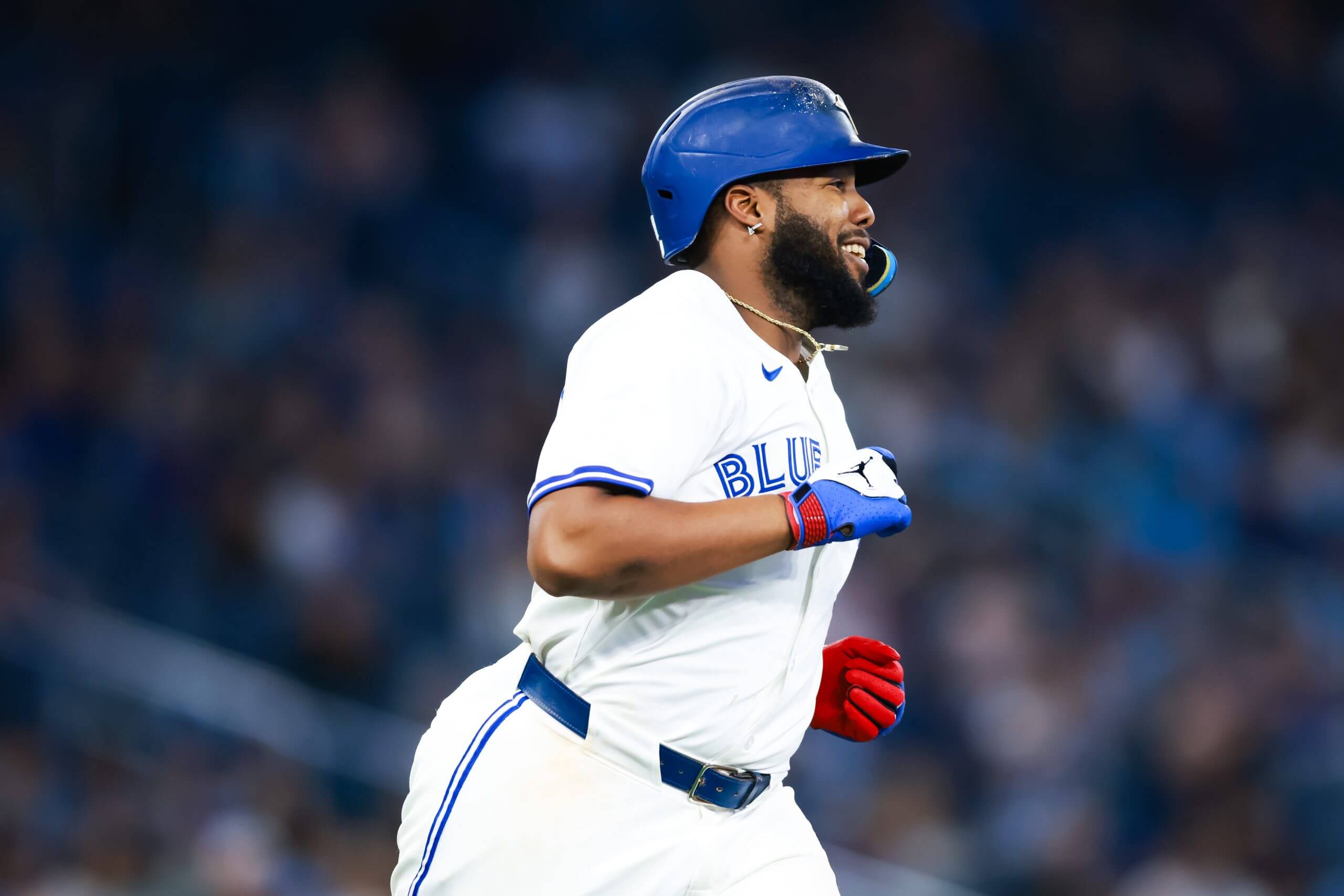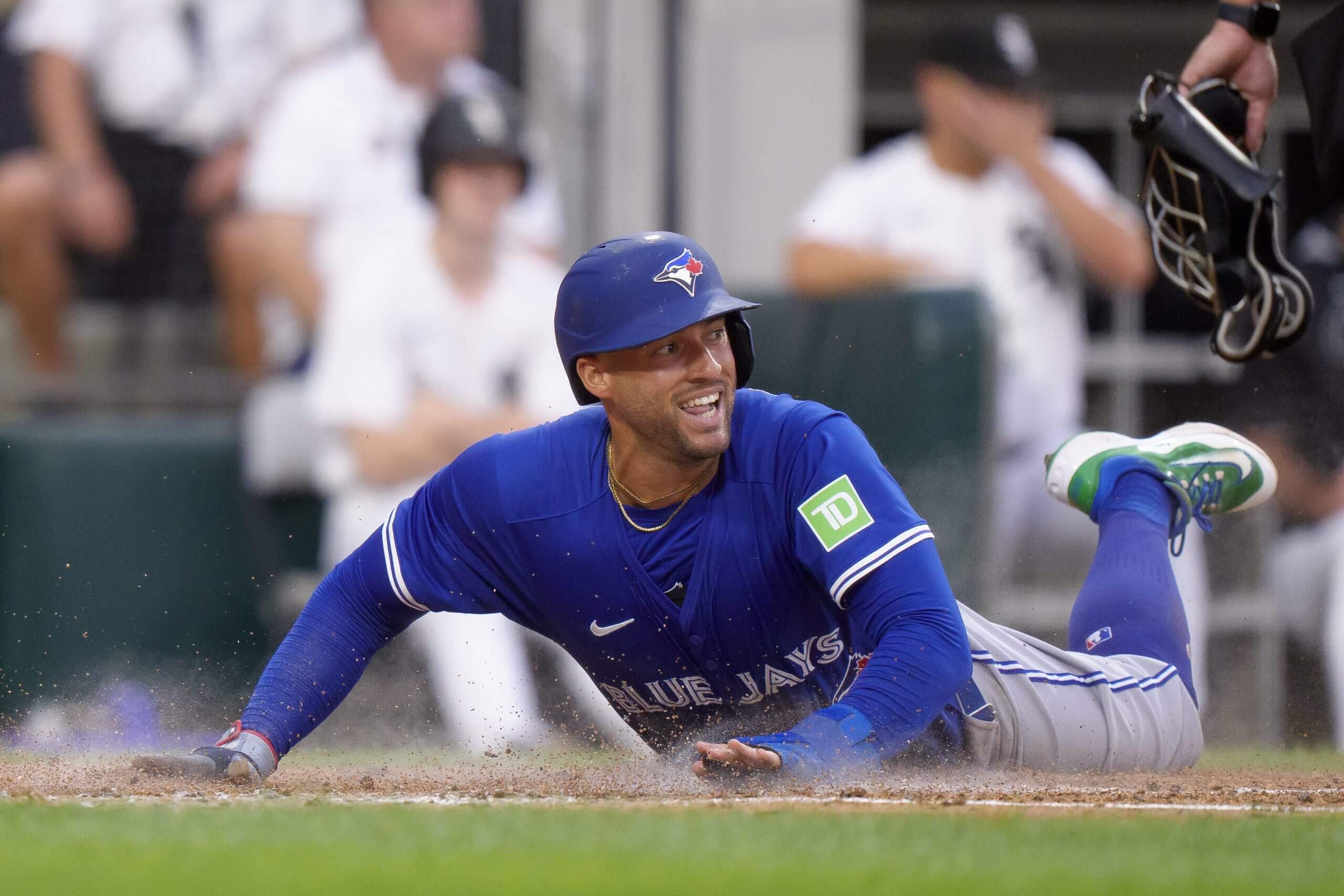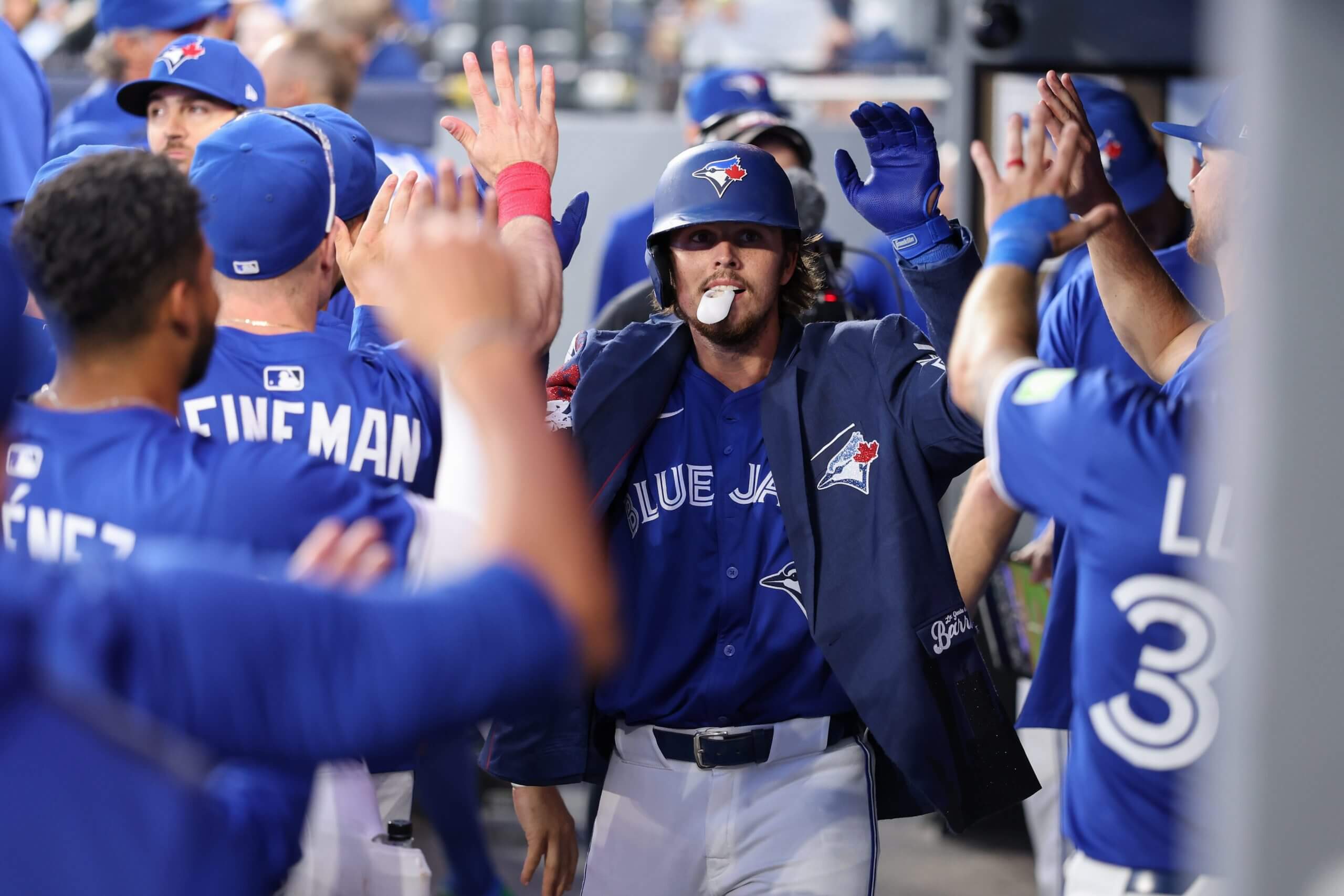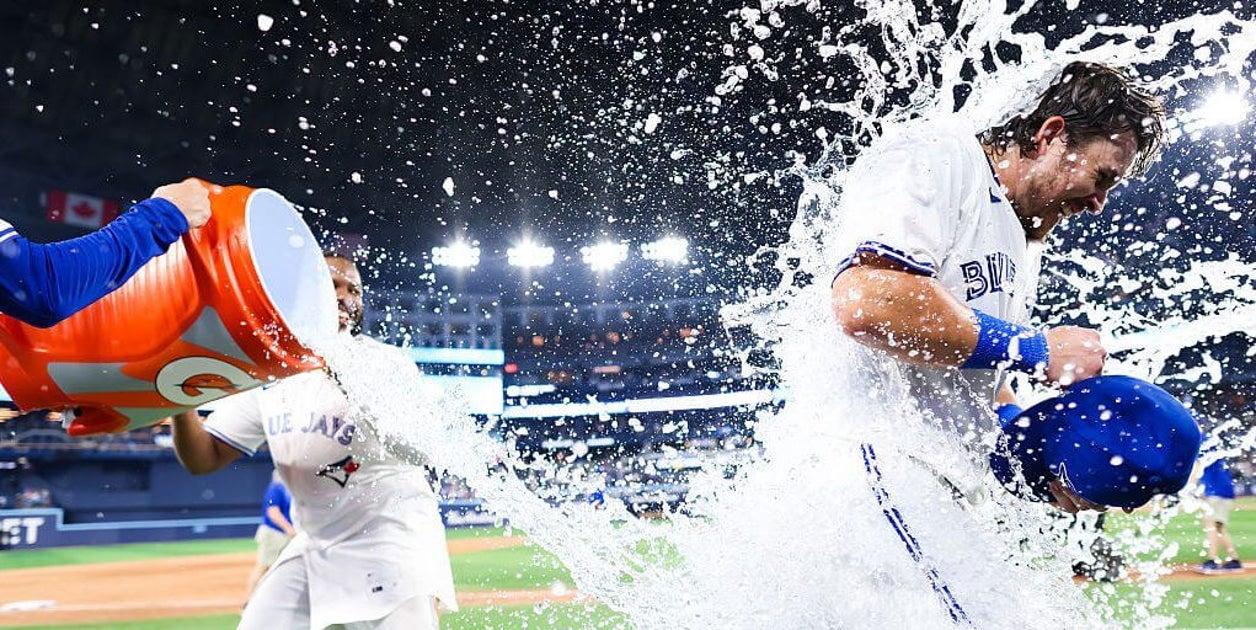The visiting clubhouse brimmed with a quiet confidence. Players slid through narrow hallways with looseness, peeking at pregame scouting reports and bouncing out to the batting cage. At the centre of it all, four Toronto Blue Jays sat huddled around a wooden table.
Hours before the Jays trotted onto the field to secure their 10th consecutive victory earlier this month, utilityman Davis Schneider pulled a red playing card from a central pile, tucking it into his guarded hand. Staring over from his locker, Joey Loperfido thought for a moment. The young outfielder had just been asked about the 2025 Blue Jays. How were they different? How had they surged to the top of the American League East?
As Loperfido began to speak, the group at the table laid down their hands. Someone — if you’re going off the loudest cheer, it was Myles Straw — had just won. They screamed and hollered, and from across the room, Loperfido reached for his answer.
“I think you see it right there.”
As Toronto rattled off victories and soared to the top of its division, everything went right. Players from Triple A notched game-saving hits the very same night they were promoted. Rookie relievers locked down games in extra innings. The group outplayed its expected record by five wins.
When asked to explain the transformation, the players point to each other.
The Jays didn’t turn from disappointment to contender with a major winter splash. Instead, Roki Sasaki became the latest offseason disappointment for fans who clamoured for a free-agent saviour. There would be no Shohei Ohtani or Juan Soto signing to lift this team to greatness. And even the more modest offseason additions the Jays brought in haven’t played a particularly prominent role in the turnaround. The difference between the failures of Toronto’s turbulent 2024 season and the successes thus far of a reinvigorating 2025 campaign, they say, lies in the culture.
“Since I’ve been here, this is one of the best years that I’ve been in the clubhouse,” Vladimir Guerrero Jr. said through interpreter Hector Lebron. “Once I wake up, I just can’t wait to get to the field to be with my teammates. It’s been unbelievable. It’s what any manager would want, a team like that, a culture like that.”

Vladimir Guerrero Jr. has been part of the difference in this year’s Blue Jays. (Cole Burston / Getty Images)
The change manifests in the dugout, which is typically buzzing during close games. The Jays point to a fresh commitment to base running, improved communication, hitters accepting more specific roles and pitchers empowered to adjust, even if it means bucking industry norms. Now, they begin the second half of a season filled with promise after completing the organization’s best first half since 1992 — the year Toronto won the first of two straight World Series titles.
It’s a stark, almost unbelievable, contrast from Toronto’s trade deadline fire sale a year ago, during a dismal season that ended in last place. That 74-win campaign opened eyes to what the Jays needed to improve, multiple players said. In a way, this year’s bountiful wins are a product of those many losses.
This winter began with conversations, led by Toronto’s veteran core. An organizational debriefing, veteran starter Kevin Gausman called it. Players texted players, coaches held meetings and calls, scouts chimed in, and the front office listened. They established a list of issues and went about correcting them. This improbable run to the top of the AL East — this ostensibly unyielding culture — has been exactly what they imagined.
“Sometimes, you got to go through some s— to really basically get exposed and fix issues,” veteran righty Chris Bassitt said. “I feel like last year, I never want to go through it again. It exposed a lot of things, and I never want to go through it again.”
As Guerrero’s groundball hit rolled inside third base, George Springer bolted. The deeper the ball dribbled into the Chicago White Sox outfield, the faster Springer ran. As he rounded second base during a game last month, Davis Schneider stood in the Jays’ dugout, slapping the foam pad in front of him. As Springer passed third and slid safely home, Schneider threw his hands in the air.
That effective aggressiveness on the bases is something the team has tried to instill for years. Ahead of spring training in 2023, better base running was manager John Schneider’s stated goal. That year, the Jays ended up as the fifth-worst base-running team in MLB, per Baseball Savant’s extra bases taken. Last year, they fell to third worst.
The 2025 Jays, by average sprint speed, are slower than the previous two iterations of the team. But, in bases taken, they rank above league average. That success is meant to send a bigger message.
“What we can control,” Schneider said, “is effort, anticipation and aggressiveness.”
It took a lot of “direct conversations,” Schneider said, a continuation of the honest discussions started in the offseason. The coaching staff presented numbers to Toronto’s roster, explaining the runs lost by being one of baseball’s worst base-running teams. They’d done that before, but it takes a veteran tone to set a standard.
This year, the two players who have been among Toronto’s biggest risers in trying for extra bases are Guerrero, who recently signed a $500 million extension, and Springer, who previously held Toronto’s largest-ever contract.
In fact, Springer has entirely embraced the mentality. On days he’s the team’s designated hitter, Springer’s listed position on the lineup card flashing on a digital screen inside Toronto’s home clubhouse often reads ‘OP.’ It’s short for offensive player, a moniker coined by associate manager DeMarlo Hale and Schneider. It’s a reminder that scoring runs isn’t entirely about hitting and that edges can be gained through effort.
The Blue Jays didn’t get faster this season, but they nevertheless got better at base running.
“For lack of a better term, s— runs downhill,” Schneider said. “So I hear it, I say to the staff, we go to the players. Then players are going to players, and they hold each other accountable.”

Veteran George Springer has helped lead the Blue Jays’ improvement on the bases. (Matt Dirksen / Getty Images)
Of course, other changes that have led to the Blue Jays’ resurgence aren’t quite as quantifiable, nor have they unfolded in plain view. Some of them have taken shape in places like the manager’s hotel room at 2 in the morning.
That’s where Schneider pulled out a whiteboard during an April trip to Houston. Hale and hitting coaches David Popkins and Lou Iannotti sat sprawled across the manager’s hotel room. As the coaches tossed out lineup concepts, the manager jotted down potential batting orders with his rounded letters, erasing one idea before moving on to the next. The Jays concoct lineups days in advance. They are malleable — accounting for hot streaks, injuries or pitching changes — but a general plan exists.
This season, those concepts are being communicated to players up and down the roster. By the time players get back to the hotel after a game, they often know whether they’re in the next day’s lineup and what position they’re playing.
That ample notice, players say, has made it easier to accept their roles and made them more willing to pass the big moment to the next man. It has fostered a new day, new hero mantra around the team. One game, it’s Springer driving in seven runs, the next it’s Ernie Clement delivering a walk-off.
The Jays’ dugout sounds like a space occupied by a team on pace for 93 wins. Batters nestle beside the hitting staff, and off-day pitchers listen in on pitching plans between innings.
“I wish more people could kind of hear what it’s like in our dugout,” Schneider said. “From a variety of people. Whether it’s the starting pitcher, pitchers that aren’t pitching or guys that aren’t starting. It’s a pretty cool atmosphere right now.”
It’s the atmosphere of any winning team Bassitt has ever been on, he said, though for the Blue Jays, the impact reaches beyond just good vibes. Three innings into his July 3 start against the New York Yankees, Bassitt ditched his cutter. It was a key part of the attack plan against New York — 10 of the Yankees’ 12 regular hitters whiff over 20 percent against the pitch, and in Bassitt’s last outing against the Bronx Bombers, he threw cutters 23 percent of the time.
But on this night, he couldn’t locate the pitch. When Trent Grisham hammered a cutter right down the middle, sending it 409 feet to the bleachers, Bassitt altered course. The veteran starter returned to the dugout, explained the issue, and the pitching plan changed. Only six of his next 67 pitches were cutters. What happened next, Bassitt said, is Toronto’s 2025 difference.
Bassitt’s decision to ditch his cutter filtered up and down the dugout. Players took note. First-base coach Mark Budzinski altered outfield alignments, and the infield shifts were tweaked to accommodate the change in plans. Pitchers feel more empowered to make those in-game adjustments this year, Bassitt said, because they know they will be supported.
“If we want to change anything at any moment, we have the ability to change things at any moment,” Bassitt said. “I know that’s not the norm around the league. Like, a lot of the time, it’s ‘hey, do this and just shut up and do it.’ That’s just not what we’re doing here.”

Addison Barger celebrates in the Blue Jays dugout, which has been a lively place this season. (Michael Chisholm / MLB Photos via Getty Images)
Last year, the Blue Jays entered the All-Star break seven games under .500 and 8 1/2 wins out of a postseason spot. The looming trade deadline selloff was obvious at that point. The October dream was over early. As the dreadful season wore on, Bassitt said it became “almost impossible” not to play for individual stats and personal outcomes.
There is no team culture that can survive that level of losing — hopes dashed that early. It’s a slide the 2025 Jays sought to avoid, to the point their preseason conversations focused on this goal.
“I think every player has some sort of individual agenda, or maybe not agenda, but something underlying,” said Bo Bichette, one of the faces of the franchise. “Like maybe they’re not playing as much as they want, or they’re not playing the position they want. Everybody has those, it doesn’t mean that they’re not here trying to win. But just trying to keep those kinds of things at bay, keep the focus on winning.”
Toronto entered the season knowing the first month would be tough. Six of the club’s first nine series came against opponents coming off appearances in the postseason. The April goal was .500 baseball — survive the spring. They finished that month 14-16. Since then, the Blue Jays are 41-25, the best record in all of baseball over that stretch.
Maybe it was a scorching-hot month and breakouts from Addison Barger and Springer that kickstarted the climb. Maybe it was a dash of the good fortune required to overperform their plus-20 run differential, and the unheralded Eric Lauer saving the rotation. Or, maybe it was a matter of culture. Whatever the reason, winning perpetuates winning, even when the possibility seems remote. The Blue Jays’ first-half surge was powered in part by their 27 comeback victories.
“It’s easy to buy in when there’s so many people around you that are bought in,” rookie reliever Braydon Fisher said. “It’s also easy to buy in when you’re winning. And it’s easy to buy in when we’re playing electric baseball games.”
This year, the Jays entered the break with excitement. It wasn’t a four-day reprieve from a dismal season, but a needed break before a second-half battle for first place. After reshaping priorities in offseason texts and phone calls, it’s where they hoped to be. Now, the Blue Jays hope to stay there.
“I’m just happy that everyone has bought in,” Bassitt said. “But now it’s just continuing. Obviously, we have a lot of games left. We’re probably going to go through stretches that are not that great for four or five games in a row. But don’t change that thought process. This thought process is why we’re really good right now.”
(Top photo of Addison Barger: Cole Burston / Getty Images)
